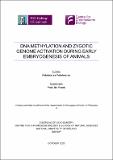| dc.description.abstract | Upon fertilization, after the fusion of two pronuclei, the newly formed zygotic genome is transcriptionally inactive. Hence, early animal development is driven by maternal RNAs and proteins. The zygotic genome becomes transcriptionally active several cell cycles later but the mechanisms that initiate zygotic genome activation (ZGA) remain largely unknown. Here, I propose a role for N6-methyldeoxyadenosine (6mA) in regulating ZGA during early development of animals.
Using ethyl-uridine incorporation in the cnidarian Hydractinia, I found that the major wave of ZGA occurs at the 64-128 cell stage. Then, using mass-spectrometry, I found that during early embryogenesis 6mA levels increase to 3-fold above background level, peaking at the 16-32 cell stage. At the 64-128 cell stage, concomitant with the major wave of ZGA, a marked decrease in 6mA methylation was observed. I propose that 6mA transiently halts zygotic transcription, which otherwise would commence at the 16-32cell stage, while keeping relevant genes poised for transcription. Once this temporal block is removed, transcription is free to commence. To confirm this proposal, I developed a shRNA mediated knockdown protocol in Hydractinia aiming to knock down genes encoding 6mA methyltransferases (Mettl4 and N6amt1) and oxidoreductase that initiates demethylation (Alkbh4 and Alkbh1)
At 64-128 cell embryos, downregulation of Alkbh1, a 6mA “demethylator”, maintained the level of 6mA high, and the EU incorporation (hence ZGA) low. This shows that high level of 6mA beyond 16-32 cell stage blocks transcription in Hydractinia. However, shRNA mediated knockdown of two putative 6mA methyltransferases failed to alter EU incorporation and ZGA of Hydractinia early embryos. I hypothesize that 6mA accumulation in the genome is a result of “accidental” incorporation from reduced m6A which derived from maternal RNA degradation.
I provide circumstantial evidence consistent with a scenario in which 6mA accumulates at the 16-32 cell stage randomly, resulting from recycling of methylated, zygotically degraded RNAs. Thus, it circumvents the need for functional 6mA methyltransferases to explain the 6mA accumulation at 16-32 cell embryos of Hydractinia. In the broader context, it suggests that 6mA is a forfuitous incorporation in animal genomes rather than an epigenetic mark. Alkbh1, therefore, purges contaminating 6mA, facilitating transcription. | en_IE |


